#Royal Belgium Pool
Explore tagged Tumblr posts
Text
D-Day was 80 years ago today!
D-Day was the first day of Operation Overlord, the Allied attack on German-occupied Western Europe, which began on the beaches of Normandy, France, on 6 June 1944. Primarily US, British, and Canadian troops, with naval and air support, attacked five beaches, landing some 135,000 men in a day widely considered to have changed history.
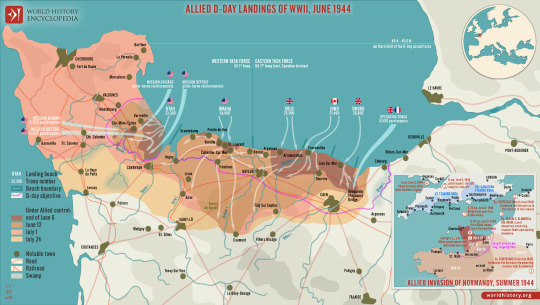
Where to Attack?
Operation Overlord, which sought to attack occupied Europe starting with an amphibious landing in northwest France, Belgium, or the Netherlands, had been in the planning since January 1943 when Allied leaders agreed to the build-up of British and US troops in Britain. The Allies were unsure where exactly to land, but the requirements were simple: as short a sea crossing as possible and within range of Allied fighter cover. A third requirement was to have a major port nearby, which could be captured and used to land further troops and equipment. The best fit seemed to be Normandy with its flat beaches and port of Cherbourg.
The Atlantic Wall
The leader of Nazi Germany, Adolf Hitler (1889-1945), called his western line of defences the Atlantic Wall. It had gaps but presented an impressive string of fortifications along the coast from Spain to the Netherlands. Construction of gun batteries, bunker networks, and observation posts began as early as 1942.
Many of the German divisions were not crack troops but inexperienced soldiers, who were spending more time building defences than in vital military training. There was a woeful lack of materials for Hitler's dream of the Atlantic Wall, really something of a Swiss cheese, with some strong areas, but many holes. The German army was not provided with sufficient mines, explosives, concrete, or labourers to better protect the coastline. At least one-third of gun positions still had no casement protection. Many installations were not bomb-proof. Another serious weakness was naval and air support. The navy had a mere 4 destroyers available and 39 E-boats while the Luftwaffe's (German Air Force's) contribution was equally paltry with only 319 planes operating in the skies when the invasion took place (rising to 1,000) in the second week.
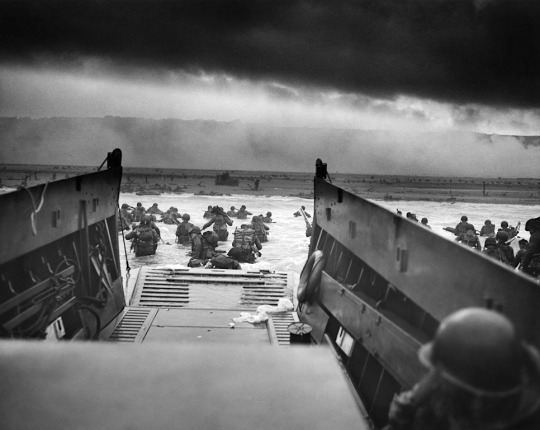
Neptune to Normandy
Preparation for Overlord occurred right through April and May of 1940 when the Royal Air Force (RAF) and United States Air Force (USAAF) relentlessly bombed communications and transportation systems in France as well as coastal defences, airfields, industrial targets, and military installations. In total, over 200,000 missions were conducted to weaken as much as possible the Nazi defences ready for the infantry troops about to be involved in the largest troop movement in history. The French Resistance also played their part in preparing the way by blowing up train lines and communication systems that would ensure the defenders could not effectively respond to the invasion.
The Allied fleet of 7,000 vessels of all kinds departed from English south-coast ports such as Falmouth, Plymouth, Poole, Portsmouth, Newhaven, and Harwich. In an operation code-named Neptune, the ships gathered off Portsmouth in a zone called 'Piccadilly Circus' after the busy London road junction, and then made their way to Normandy and the assault areas. At the same time, gliders and planes flew to the Cherbourg peninsula in the west and Ouistreham on the eastern edge of the planned landing. Paratroopers of the 82nd and 101st US Airborne Division attacked in the west to try and cut off Cherbourg. At the eastern extremity of the operation, paratroopers of the 6th British Airborne Division aimed to secure Pegasus Bridge over the Caen Canal. Other tasks of the paratrooper and glider units were to destroy bridges to impede the enemy, hold others necessary for the invasion to progress, destroy gun emplacements, secure the beach exits, and protect the invasion's flanks.

The Beaches
The amphibious attack was set for dawn on 5 June, daylight being a requirement for the necessary air and naval support. Bad weather led to a postponement of 24 hours. Shortly after midnight, the first waves of 23,000 British and American paratroopers landed in France. US paratroopers who dropped near Ste-Mère-Église ensured this was the first French town to be liberated. From 3.00 a.m., air and naval bombardment of the Normandy coast began, letting up just 15 minutes before the first infantry troops landed on the beaches at 6.30 a.m.
The beaches selected for the landings were divided into zones, each given a code name. US troops attacked two, the British army another two, and the Canadian force the fifth. These beaches and the troops assigned to them were (west to east):
Utah Beach - 4th US Infantry Division, 7th US Corps (1st US Army commanded by Lieutenant General Omar N. Bradley)
Omaha Beach - 1st US Infantry Division, 5th US Corps (1st US Army)
Gold Beach - 50th British Infantry Division, 30th British Corps (2nd British Army commanded by Lieutenant-General Miles C. Dempsey)
Juno Beach - 3rd Canadian Infantry Division (2nd British Army)
Sword Beach - 3rd British Infantry Division, 1st British Corps (2nd British Army)
In addition, the 2nd US Rangers were to attack the well-defended Pointe du Hoc between Utah and Omaha (although it turned out the guns had never been installed there), while Royal Marine Commando units attacked targets on Gold, Juno, and Sword.
The RAF and USAAF continued to protect the invasion fleet and ensure any enemy ground-based counterattack faced air attack. As the Allies could put in the air 12,000 aircraft at this stage, the Luftwaffe's aerial fightback was pitifully inadequate. On D-Day alone, the Allied air forces flew 15,000 sorties compared to the Luftwaffe's 100. Not one single Allied aircraft was lost to enemy fire on D-Day.

Packing Normandy
By the end of D-Day, 135,000 men had been landed and relatively few casualties were sustained – some 5,000 men. There were some serious cock-ups, notably the hopeless dispersal of the paratroopers (only 4% of the US 101st Air Division were dropped at the intended target zone), but, if anything, this caused even more confusion amongst the German commanders on the ground as it seemed the Allies were attacking everywhere. The defenders, overcoming the initial handicap that many area commanders were at a strategy conference in Rennes, did eventually organise themselves into a counterattack, deploying their reserves and pulling in troops from other parts of France. This is when French resistance and aerial bombing became crucial, seriously hampering the German army's effort to reinforce the coastal areas of Normandy. The German field commanders wanted to withdraw, regroup and attack in force, but, on 11 June, Hitler ordered there be no retreat.
All of the original invasion beaches were linked as the Allies pushed inland. To aid thousands more troops following up the initial attack, two artificial floating harbours were built. Code-named Mulberries, these were located off Omaha and Gold beaches and were built from 200 prefabricated units. A storm hit on 20 June, destroying the Mulberry Harbour off Omaha, but the one at Gold was still serviceable, allowing some 11,000 tons of material to be landed every 24 hours. The other problem for the Allies was how to supply thousands of vehicles with the fuel they needed. The short-term solution, code-named Tombola, was to have tanker ships pump fuel to storage tanks on shore, using buoyed pipelines. The longer-term solution was code-named Pluto (Pipeline Under the Ocean), a pipeline under the Channel to Cherbourg through which fuel could be pumped. Cherbourg was taken on 27 June and was used to ship in more troops and supplies, although the defenders had sunk ships to block the harbour and these took some six weeks to fully clear.
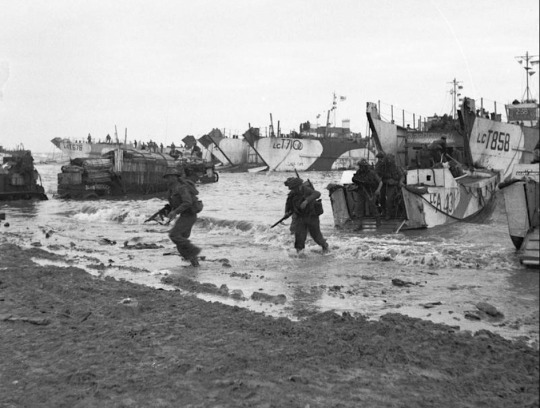
Operation Neptune officially ended on 30 June. Around 850,000 men, 148,800 vehicles, and 570,000 tons of stores and equipment had been landed since D-Day. The next phase of Overlord was to push the occupiers out of Normandy. The defenders were not only having logistical problems but also command issues as Hitler replaced Rundstedt with Field Marshal Günther von Kluge (1882-1944) and formally warned Rommel not to be defeatist.
Aftermath: The Normandy Campaign
By early July, the Allies, having not got further south than around 20 miles (32 km) from the coast, were behind schedule. Poor weather was limiting the role of aircraft in the advance. The German forces were using the countryside well to slow the Allied advance – countless small fields enclosed with trees and hedgerows which limited visibility and made tanks vulnerable to ambush. Caen was staunchly defended and required Allied bombers to obliterate the city on 7 July. The German troops withdrew but still held one-half of the city. The Allies lost around 500 tanks trying to take Caen, vital to any push further south. The advance to Avranches was equally tortuous, and 40,000 men were lost in two weeks of heavy fighting. By the end of July, the Allies had taken Caen, Avranches, and the vital bridge at Pontaubault. From 1 August, Patton and the US Third Army were punching south at the western side of the offensive, and the Brittany ports of St. Malo, Brest, and Lorient were taken.
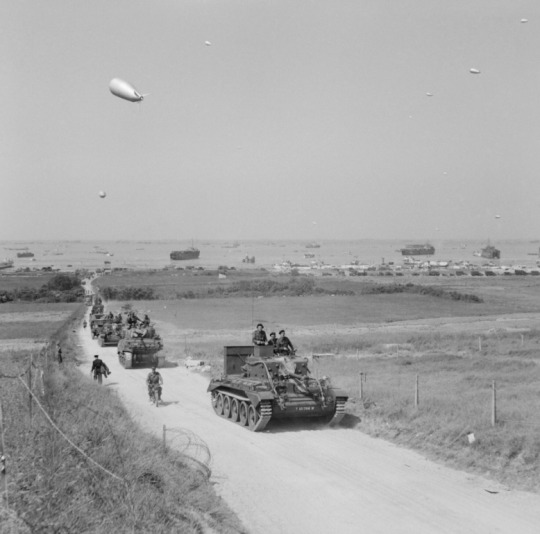
German forces counterattacked to try and retake Avranches, but Allied air power was decisive. Through August 1940, the Allies swept southwards to the Loire River from St. Nazaire to Orléans. On 15 August, a major landing took place on the southwest coast of France (French Riviera landings) and Marseille was captured on 28 August. In northern France, the Allies captured enough territory, ports, and airfields for a massive increase in material support. On 25 August, Paris was liberated. By mid-September, the Allied troops in the north and south of France had linked up and the campaign front expanded eastwards pushing on to the borders of Germany. There would be setbacks like Operation Market Garden of September and a brief fightback at the Battle of the Bulge in December 1944, but the direction of the war and ultimate Allied victory was now a question of not if but when.
138 notes
·
View notes
Note
Hello duchess! I’m new to royal watch and I just found out that queen Margareth of Denmark sister is also a queen! Is royals marrying other royals common nowadays or do you think we won’t see royals marrying royals for a long time now?
My name's Jessica :) It is not as common as it used to be. Most of the inter-royal marriages are amongst those who are over 60 or they're deposed royals whose titles don't mean anything (you regularly see the pretender to some tiny German throne marrying the pretender to a throne of an Eastern European nation that doesn't exist anymore etc). Some examples (not an exhaustive list before people start with the THIS PERSON IS ANOTHER EXAMPLE nonsense):
Anne Marie is Queen Margrethe of Denmark's sister and married King Constantine of Greece.
Constantine's sister Sofia married King Juan Carlos of Spain
Princess Caroline of Monaco is still legally married to Prince Ernst August of Hanover (they live apart).
Princess Haya of Jordan - half sister of the King of Jordan - recently divorced Sheih Mohammed bin Rashid Al Maktoum who is the Ruler of Dubai
Princess Margaretha is the sister of Grand Duke Henri of Luxembourg and is married to the brother of Prince Hans-Adam of Liechtenstein
Lots of royals married into German or Austrian houses including Princess Birgitta who is the sister of the King of Sweden, Princess Astrid who is the sister of the King of Belgium, Margrethe and Sofia's other sister Princess Benedikte, Grand Duke Henri of Luxembourg's other sister Marie-Astrid etc, Prince Alois of Liechtenstein who is the heir and married a Bavarian royal.
It's not the case that royals all got some sort of memo saying they couldn't marry each other any more. It was just a natural thing. They no longer had to marry each other because countries didn't forge political alliances that way anymore. They had all been fighting each other during the wars so it was safer to marry someone from your own country. And then over time they started to go to ordinary schools or go to university with normal people or go clubbing and societal attitudes shifted and so they met different kinds of people than their ancestors would have met. So I don't think for a second that William and Kate or Victoria and Daniel are whispering into their kids' ears at night trying to convince them not to marry a royal, but whereas their ancestors might have had a pool of 10 eligible candidates to draw from because they only went to debutante balls and hunting trips with other royals, now they have access to essentially an unlimited number of people and so the probability has dropped that it will be another member of this comparatively small social class
18 notes
·
View notes
Text
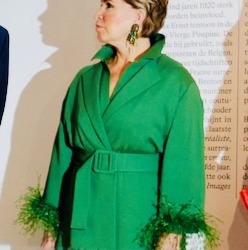



Through the Years → Maria Teresa, Grand Duchess of Luxembourg (499/∞) 17 April 2024 | Grand Duchess Maria Teresa of Luxembourg talks to a group of young fencing athletes as she greets the public after a visit to the Sint-Baafskathedraal (St Bavo's Cathedral), in Gent, on the second day of the official state visit of the Luxembourg royal couple to Belgium. (Photo by Frédéric Andrieu/Pool/AFP via Getty Images)
#Grand Duchess Maria Teresa#Luxembourg#2024#Frederic Andrieu#Pool#AFP via Getty Images#through the years: Maria Teresa
2 notes
·
View notes
Text
Love in a Time of War - (History huh? Bet they already made some....)
Love in a Time of War - (History, huh? Bet they already made some....) https://ift.tt/09qZ3Ul by Djokodal_Fan July 1940. The German Wehrmacht has rolled through Poland, Belgium, Netherlands, Denmark and Norway, and has forced the capitulation of France. Spain under the Dictatorship of Caudillo Francisco Franco is still officially a 'non belligerent', but is heavy tilting towards the Axis Powers of Germany and Italy. Henry Fox, Second Secretary at the Embassy of His Brittanic Majesty's Government in Spain, and Alexander Claremont-Diaz, Commercial Attaché at the US Embassy, are tasked by their respective Ambassadors to work together to pool and coordinate intelligence sources - for the benefit of both their countries and to aid in the war effort, and to prepare for any potential widening of the theatres of war. Despite the acrimonious circumstances of their first meeting, Alex and Henry gradually develop a rapport. As their bond grows from hostility to a friendship based on mutual respect and affection - and then teeters on the brink of something more, something truly special - can they find their way together in an age which deems Love between two men as a crime? And what impact will the traumatic treatment Henry has endured in the past, have on the decisions they now have to make together? Words: 8896, Chapters: 1/4, Language: English Fandoms: Red White & Royal Blue - Casey McQuiston, Red White & Royal Blue (2023) Rating: Mature Warnings: Creator Chose Not To Use Archive Warnings Categories: M/M Characters: Alex Claremont-Diaz, Henry Fox-Mountchristen-Windsor, Historical Character(s), King James III (Red White & Royal Blue), Hunter (Red White & Royal Blue), Arthur Fox, Oscar Diaz (Red White & Royal Blue), Ellen Claremont, Catherine Fox-Mountchristen-Windsor, June Claremont-Diaz, Percy "Pez" Okonjo Relationships: Alex Claremont-Diaz/Henry Fox-Mountchristen-Windsor Additional Tags: Alternate Universe - World War II, Historical References, Partial Historical Inaccuracy, Period-Typical Homophobia, Period Typical Bigotry, Period Typical Attitudes, Misunderstandings, Undiagnosed PTSD, Secrets, Gay Henry Fox-Mountchristen-Windsor, Bisexual Alex Claremont-Diaz via AO3 works tagged 'Alex Claremont-Diaz/Henry Fox-Mountchristen-Windsor' https://ift.tt/mf0TsVi November 28, 2023 at 09:11AM
2 notes
·
View notes
Text

&&. announcing his royal highness, 𝐥𝐞𝐨𝐩𝐨𝐥𝐝 𝐩𝐡𝐢𝐥𝐢𝐩𝐩𝐞 𝐦𝐚𝐫𝐢𝐞 𝐝𝐞 𝐬𝐚𝐱𝐞-𝐛𝐨𝐛𝐨𝐮𝐫𝐠 𝐞𝐭 𝐠𝐨𝐭𝐡𝐚 , the 𝟐𝟒 year old 𝐩𝐫𝐢𝐧𝐜𝐞 of 𝐛𝐞𝐥𝐠𝐢𝐮𝐦 . he is often confused with 𝐣𝐨𝐫𝐝𝐚𝐧 𝐛𝐚𝐫𝐫𝐞𝐭𝐭 . some say that he is 𝐚𝐝𝐝𝐢𝐜𝐭𝐢𝐯𝐞 & 𝐬𝐭𝐮𝐛𝐛𝐨𝐫𝐧 , but he is actually 𝐠𝐫𝐞𝐠𝐚𝐫𝐢𝐨𝐮𝐬 & 𝐟𝐚𝐬𝐭𝐢𝐝𝐢𝐨𝐮𝐬 .
tw ; death , drugs , alcohol & addiction .
ok so before i go on a tangent abt leo , lemme just say i’m v excited to be here !! also i’ve tried to learn all the alliances & plot drops but my brain does not work 90 % of the time so ... that’s THAT . oh btw , i’m nikki & i go by she / her !
𝐁𝐀𝐒𝐈𝐂 𝐈𝐍𝐅𝐎𝐑𝐌𝐀𝐓𝐈𝐎𝐍
𝒇𝒖𝒍𝒍 𝒏𝒂𝒎𝒆 : leopold philippe marie de saxe-bobourg et gotha
𝒎𝒆𝒂𝒏𝒊𝒏𝒈 : " people " & “ brave ”
𝒏𝒊𝒄𝒌𝒏𝒂𝒎𝒆𝒔 : leo
𝒃𝒊𝒓𝒕𝒉 𝒅𝒂𝒕𝒆 : 17 april 1996
𝒂𝒈𝒆 : twenty-four years old
𝒛𝒐𝒅𝒊𝒂𝒄 : aries
𝒈𝒆𝒏𝒅𝒆𝒓 : cis male
𝒑𝒓𝒐𝒏𝒐𝒖𝒏𝒔 : him & he
𝒔𝒆𝒙𝒖𝒂𝒍 𝒐𝒓𝒊𝒆𝒏𝒕𝒂𝒕𝒊𝒐𝒏 : pansexual
𝒏𝒂𝒕𝒊𝒐𝒏𝒂𝒍𝒊𝒕𝒚 : belgian
𝒆𝒕𝒉𝒏𝒊𝒄𝒊𝒕𝒚 : caucasian
𝒄𝒖𝒓𝒓𝒆𝒏𝒕 𝒍𝒐𝒄𝒂𝒕𝒊𝒐𝒏 : phuket , thailand
𝒕𝒊𝒕𝒍𝒆𝒔 : prince of belgium
here’s the full stats page !!
𝐁𝐔𝐋𝐋𝐄𝐓 𝐏𝐎𝐈𝐍𝐓𝐒
leopold ( it’s just leo for those who know him best ) is the middle child of the belgian royal family , he is the crown princess louise’s younger brother & princess josephine’s older brother . at a very young age he had come to terms that he was pretty far down the line in order to ascend to the belgian throne & that knowledge shaped him into the man that he is today .
ever since he was a young child , leo had always a trick up his sleeve & always caused raucous in the belgian palace . he wanted the attention his older sister got from being the first in line heir to the throne & things got much worse when he learned he was going to have a little sister . he wouldn’t be the baby of the family anymore , he was just the middle child , sandwiched between what he could have been & what he had lost .
needless to say that his attention grabbing tricks never went away , they became only more intricate & scandalous , sources will tell you he brings shame to the belgian family name ( but at least he is bringing something ) . despite his exuberant personality , the prince often felt alone & forgotten . for a moment he had tried his hardest in his academic journey , he studied hard & was part of his school’s swimming team , but to no avail , it didn’t truly matter .
some would say it was self - fulfilling prophecy & others would just say he was born that way , but at the young age of sixteen years old , the prince had gained his infamous hedonistic reputation . of course , it only got worse over the years , but the boy drove motorcycles , had a couple dui , developed a cigarette addiction , had a high alcohol tolerance ( to say the least ) & woke up in various strangers’ beds . classic . leo was just so good at being bad .
those who have met leo would guarantee you that beauty is indeed skin deep . he has the mouth of a sailor & his boldness doesn’t cease to surprise others . despite the stereotypes , the belgian prince does enjoy reading ( by the beach if possible ! ) & arguing about nothing & everything , as long as you agree to hear him talk . he went to university & majored in sociology . despite seemingly showing disinterest for politics , it’s his sister’s thing , the blond pays frequent attention to social issues , he even has his own foundation the ‘ prince leopold foundation ’ which helps develop better rehabilitation programs in prisons .
although , the boy is not all bad . he has a ( almost ) universal sense of humour & uses to diffuse tense situations or simply to entertain himself . he can be quite judgemental of others , first impressions do stick with him . he is very loyal to his close friends & family , unfortunately that does not really in relationships . he loves trying new things & going on adventures , thus being rarely bored . doesn’t mind a bit of drama . he is a very good listener , but loves to talk as well . despite being extroverted , leo keeps to himself when he doesn’t know the other person / is disinterested . he is definitely afraid life is going to pass him by & hates labels .
𝐀𝐄𝐒𝐓𝐇𝐄𝐓𝐈𝐂𝐒
crashed cars , empty promises , early morning hangovers , green smoothies , swimming endless laps in the pool , walking around shirtless , cunning smiles , half - unbuttoned shirts , beach hair , old books with broken spines , cigarette smokes , french curse words , near - empty glass of rum & coke , eye rolls , jokes at importunate moments , disposable cameras , lipstick marks on a collar & illegible scribbles on a journal .
𝐂𝐔𝐑𝐑𝐄𝐍𝐓 𝐒𝐈𝐓𝐔𝐀𝐓𝐈𝐎𝐍
leopold is quietly mourning his mother’s death while incessantly worrying about his father condition . although , to an outsider , it would seem that the prince is just all partied out . he still keeps up with his token hedonistic ways , but has trouble sleeping at night & doesn’t seem to get any rest . it wouldn’t be unheard of to see the boy napping all over the place during the day . he is also bitter because there is more pressure for him to step up but he is ‘ quite content ’ with who he is & refuses to change . feels more alone than ever & misunderstood . he is treating his time in thailand as a holiday .
𝐂𝐎𝐍𝐍𝐄𝐂𝐓𝐈𝐎𝐍𝐒
i haven’t thought long & hard about it because i have an assignment due tomorrow but i’d definitely see all sorts of foes , bros ( includes all genders ) & hoes ( idem ) . he is involved in many scandals so if you ever need a person for that , call leo . give this intro a like & i’ll come to you for plots !!
#hshqintro#𝐑𝐄 : 𝐋𝐄𝐎𝐏𝐎𝐋𝐃 — ooc .#tl.dr ; wild child + like this if u wanna plot#this is longer than expected djs#drugs tw#addiction tw#death tw
13 notes
·
View notes
Text
Belgium Day 1
The morning was simultaneously rough and smooth at the same time. I only got about 30 minutes of sleep the night before so I was running on fumes but I somehow made my way to St Pancras International for my morning train into Brussels.
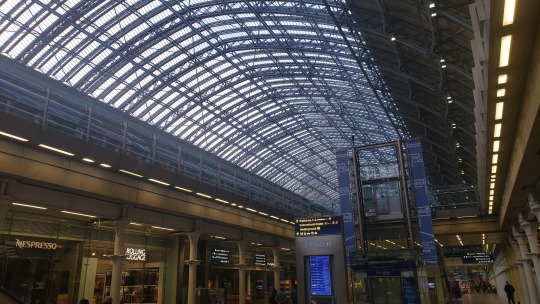
St Pancras is so peaceful in the early morning. It’s almost surreal.
I manage through the train ride, into the city, checked into my hostel at Brxxl 5 City Centre Hostel, and was ready to ACTUALLY start my Brussels exploration day. Stop #1 is the famous: Manneken Pis.
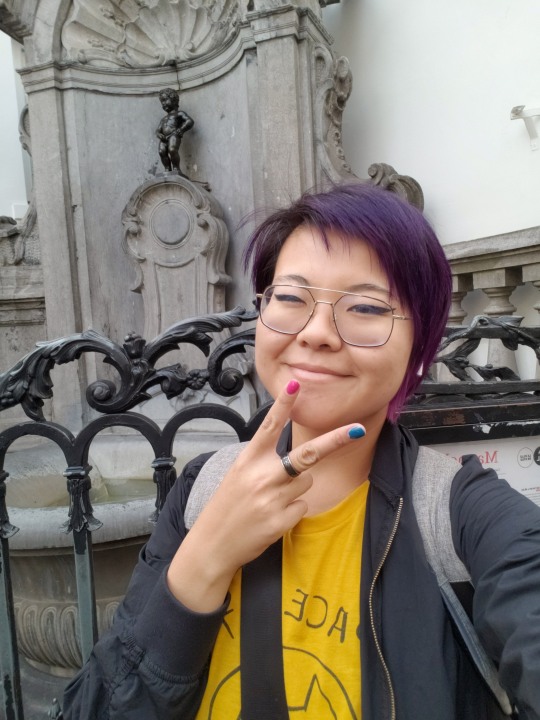
I’m not winking. I’m just so tired that opening my eyes all the way would put me into an awakeness level that I just wanted ready for.
Along my tourist route for the day, I made sure to nestle in a mini walking tour of several chocolate shops since I wouldn’t have time for a proper guided chocolate tour of my own. Stop #1 was Rudolf Braun where I picked up a bar of Dark Orange & Almonds chocolate. From there I headed over to Stop #2 of my mini chocolate tour: Choco-story, a chocolate museum. The museum is quite small and really peaceful since it was just a random Monday. They provide a self-guided walking tour that gives you some information on cacao, the history of chocolate making, etc. For such a small museum I really enjoyed it. It only took about an hour and it had some really interesting information and they incorporated some samplings and even some live demonstrations toward the end of the museum route.


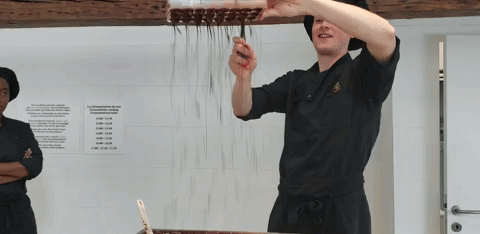
My favorite part of the Chocostory tour was definitely the live demonstrations at the end when a chocolate master demonstrated the process and gave us some fresh made Hazelnut w/ Speculoos Pralines and Coffee Pralines.
Right nearby the museum was Stop #3 of my self-designed chocolate tour: Planete Chocolate. Picked up a few goodies there and then went to my first non chocolate food stop of the day: Maison Dandoy where I got to try a fluffy and delicate Brussels-Style Waffle along with their world famous Speculoos.
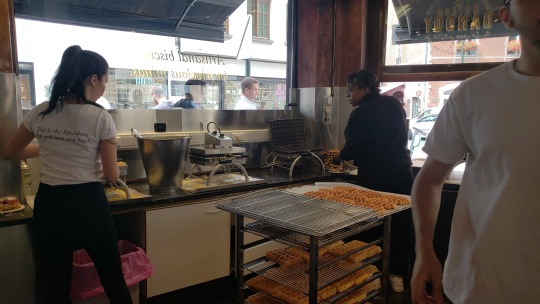
Love watching batch after batch of waffles getting churned out in this tiny shop.
My next Brussels stop was the Grand Palace/Grote Markt. This is a small square and you can easily see the whole thing from the center but it is so ornate, you can’t help but be lost in it for a while.

It was still pretty early on in the day but tourists were already beginning to pool here. A lot of the businesses weren’t open yet but the gorgeous buildings themselves are still worth a visit.
Just a few feet away from the Grand Palace was chocolate Stop #4: Chocolaterie Mary which is apparently one of King Philippe of Belgium’s favorite chocolatiers. I had to pick up one of the queen’s favorite chocolates too which was the sea salt caramel w/ pecan. Absolutely delicious! Though at this point I was feeling quite sugared out so I decided to stop for lunch at Ballekes, a small meatball shop just outside the central square.

Pork and beef meatball w/ Lapin Sauce (onion, raisin, beer) w/ a side of Belgium Fries (and a heeping helping of mayo of course).
After lunch I walked up towards the Mont de Arts. It’s a gorgeous hill overlooking the city with a lovely garden. There were some sling chairs set up and I decided this would be an appropriate spot for a short nap.
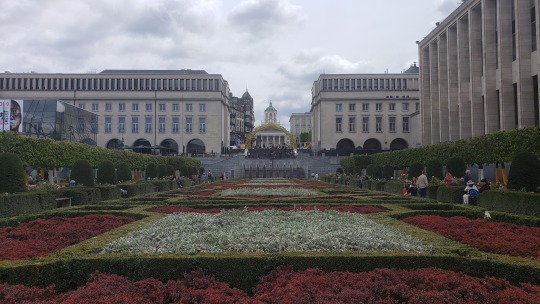

A comfy spot for a little afternoon nap before I continue with my day.
After a few minutes of shut eye I continued my journey towards the Palais de Bruxelles. Unfortunately they were closed so this was just a quick pass by.

Exterior of the Palais de Bruxelles
Finally finishing up the last leg of my tour, I passed through the Parc de Pruxelles for a zen afternoon stroll before stopping by the St. Michael and St. Gudual Cathedral and eventually towards the Galeries Royales Saint-Hubert.
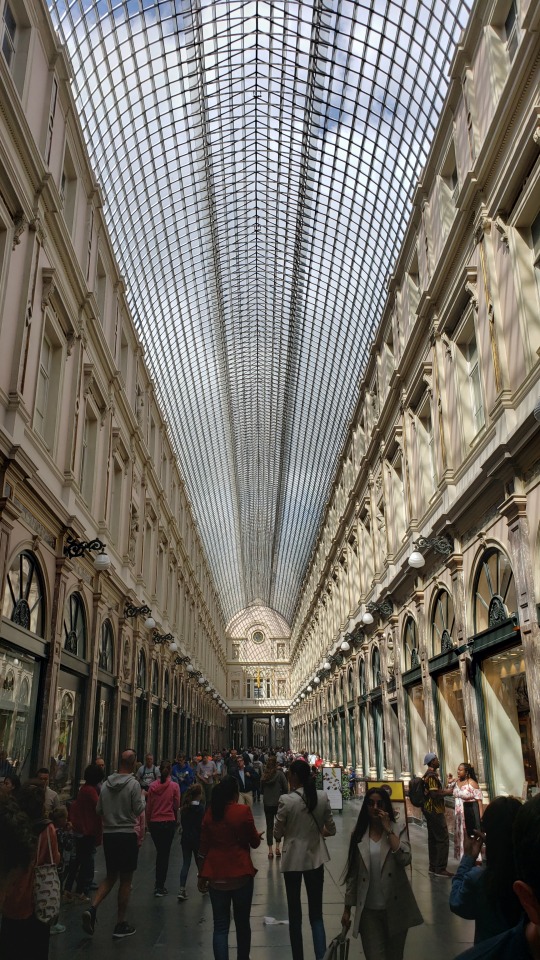
The glazed ceilings of the shopping arcade are absolutely mesmerizing.
From the gallery I made my final two chocolate stops: Stop #5 at Neuhaus Chocolates and Stop #6 at Leonidas. And with that. I ended my very chocolate (and sugar) filled day.
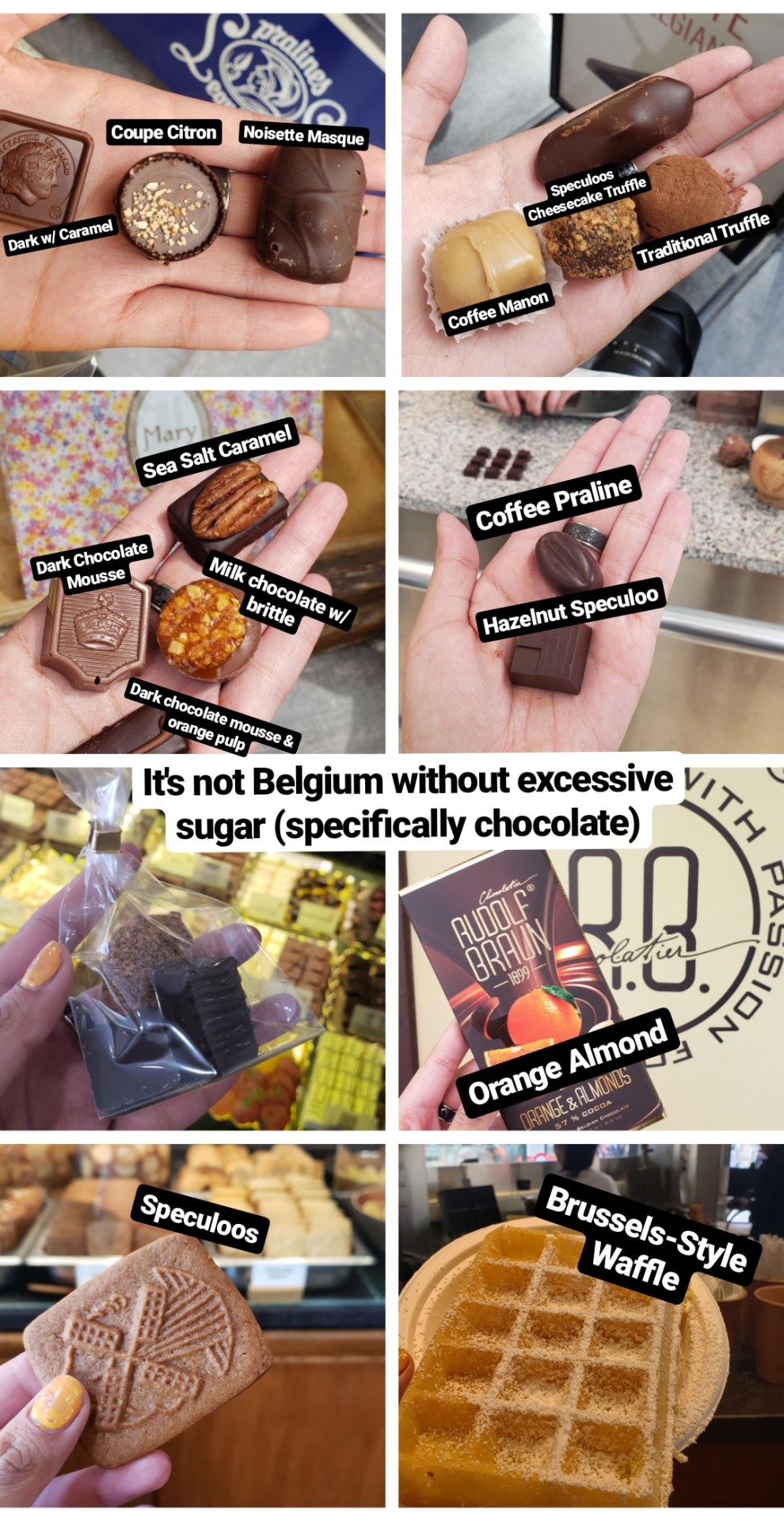
Some of these were a snack for later but you bet I ate way more sugar in one day than I should have.
I was exhausted and headed back into my hostel. After some time relaxing, I made a new friend named Lukas and we decided to grab dinner together. We wandered the streets and eventually decided on a spot called Brasserie de la Bourse for dinner.

Had to get me a piping plate of Flemish Stew and of course more Belgium Fries.
To end the night, Lukas and I head over to the Delirium Cafe for a drink. The beer hall is absolutely massive. Apparently this was a slow night according to Lukas but even then we had to fight some crowds just to get a drink. But they really have such a stellar selection of brews on tap that it’s worth the hassle.
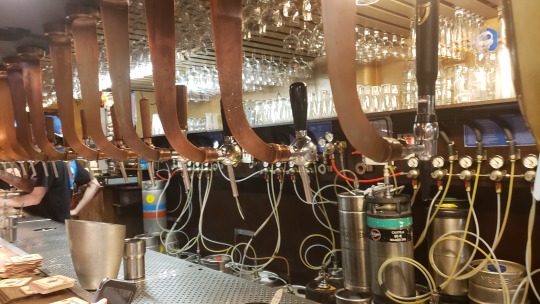
Just a small peak at what the bar setup at Delirium looks like.
The night ends, not too unreasonably late, back at the hostel where Lukas and I share a couple bottled beers before I head to bed. All in all, not a bad day for 30 minutes of sleep.
#Belgium#chocolate#Travel Photography#travel blog#europe#traveling couch potato#explore japan#food blogger#explore#food pix#food porn#food#travel diary#diary#brussels#beer#local
2 notes
·
View notes
Text
All The Looks From Beyonce’s ‘Black Is King’ Visual Album

Social media has gone into meltdown following the release of Beyonce Knowles’ new visual album ‘Black Is King,’ via Disney+ at midnight PST.
The project was written, directed, and executive produced by Beyonce, and features appearances by JAY-Z, Kelly Rowland, Naomi Campbell, Tina Knowles-Lawson, Lupita Nyong’o, Blue Ivy, and more.
‘Black Is King’ is based on the music of ‘The Lion King: The Gift’—the companion album Beyoncé made for Disney’s live-action film, of which Beyoncé voiced adult Nala.
In the film, dance sequences, Lion King samples, and footage of Black families around the world are interspersed with sequences in which Beyoncé traverses a beach, reciting details of a generations-spanning spiritual journey
The visual album was filmed across several locations including New York, Los Angeles, South Africa, West Africa, London, and Belgium.
As we’ve come to expect from a Beyonce project, the costumes are just as impressive as the visuals and the vocals.
This first look is Valentino Haute Couture leopard needlelace jumpsuit embroidered with sequins and rhinestones which sets off my jumpsuit, animal print and bedazzling senses all at once.
The jacquard leopard cape we see in the sketch didn’t get a look in here, and I really wish it did. As it would’ve added a regal air to this already powerful image.
A-Morir, who provided a few of the accessories for this film, created the rhinestone accented shades. Christian Louboutin heels completed her look.

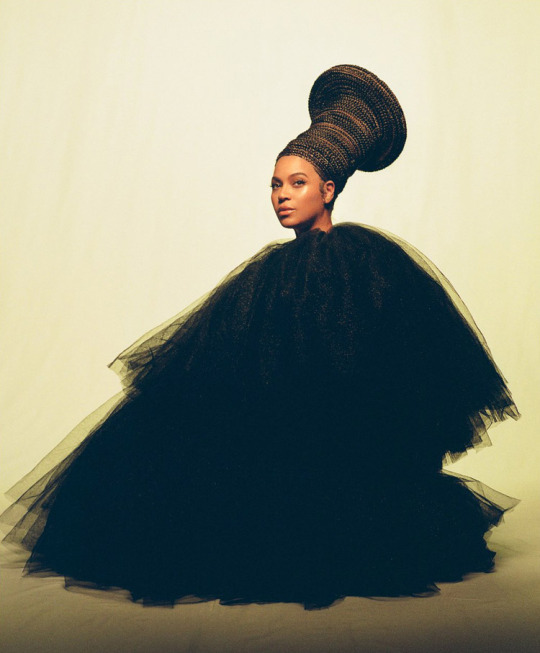
This next tulle black gown custom made by Timothy White is perhaps the most iconic look thanks to the homage paid to Egyptian queen Nefertiti via her braided updo/crown.

d.bleu.dazzled® by Destiney Bleu is known for her rhinestone accented pieces. This shimmering bodysuit and skirt from the Californian-based designer, was style with a necklace by Area, and another pair of shade by A-Morir.

Riccardo Tisci’s choice of prints for Burberry went way beyond the brand’s signature check to cow motifs for Spring 2019. Looking like a warrior about to go into battle, the mini dress paired with a matching corset was styled with metallic silver Christian Louboutin shoes and a Ram horn headdress.
Are we about to see a cow print resurgence?

We then cut to a more serene setting which sees Beyonce wearing a custom white gown by Wendy Nichol.
This look instantly reminded me of the vintage Alexander McQueen dress Kim Kardashian wore to the 2020 Vanity Fair Oscar Party, as it has the same dreamy, ethereal quality.

This Lace by Tanya embellished fringe design had me thinking back to Lizzo’s Atelier Versace dress worn to the 2020 Grammys.
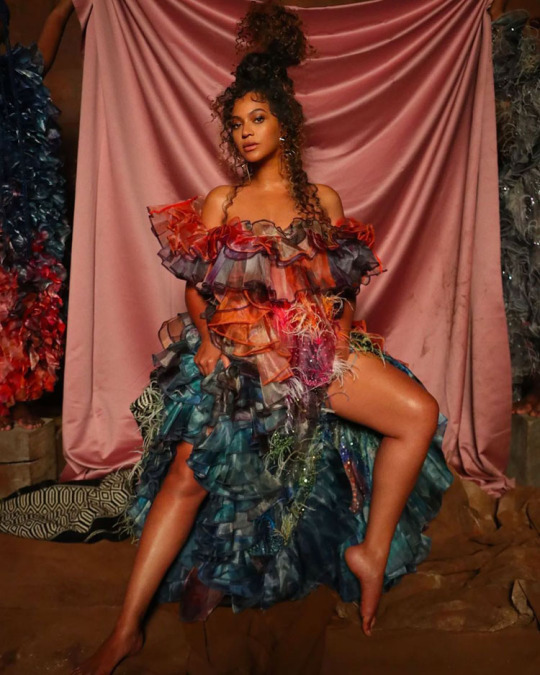
This Mary Katrantzou Fall 2019 look is among my favourites for the colours, tumbling ruffles, feather accents and the darker hair colour, which I much prefer over the blonde. I think she looks much younger and fresher with this hue.
This isn’t the first time the singer has favoured the Greek designer. As Mary created a look for Beyonce which she wore during the Global Citizen Festival concert.

Mary Katrantzou Fall 2019

Area created this colourful webbed fantasy for their Fall 2019 collection, which Beyonce brought to life in this film. The styling kept the look true the vision of the designer and film’s aesthetic prowess.
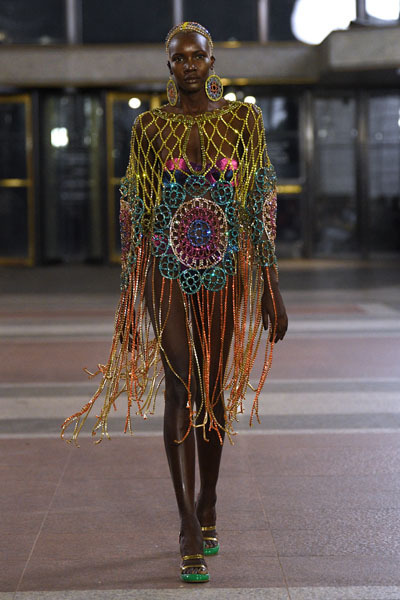
Area Fall 2019

For one of my favourite performance in this film, the singer wore a Loza Maléombho graphic, black-and-white ensemble was styled with a gold hardware including a grill.
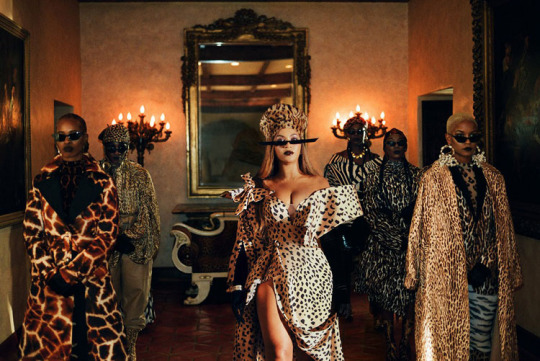
There was more animal print to be had in this cheetah print gown, which could fit right on set of ‘Coming To America,’ as well as the Wearable Art Gala, and any music awards ceremony or premiere.

Oversized hats are still on trend according to Beyonce.
This Marta Jakubowski x Jo Miller hat provided plenty of shade for her breath-taking royal blue Alejandro custom off-the-shoulder design. This feels like a Joan Collins “rich b!tch” moment.

In my mind, this sugary pink embellished ruffled swimsuit what Diane Ross wears when lounging by the pool.

There were more black ruffles to be hand in this layered creation which is almost upstaged by the braided crown.

Sipping high tea with Mama Knowles-Lawson, Beyoncé wore a dramatic Erdem floral-printed tiered gown styled with Anabela Chan earrings and an array of accessories that give the look an edge.
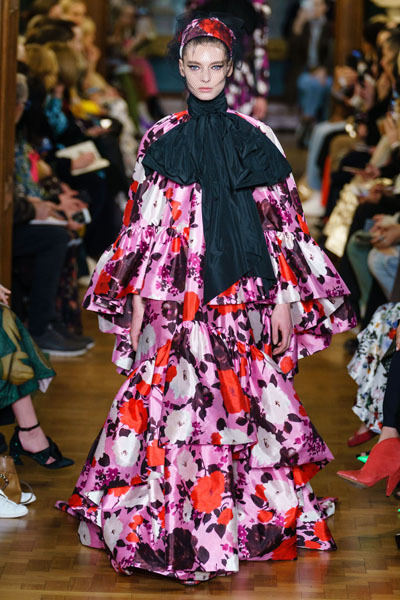
Erdem Fall 2019

This Marine Serre Fall 2019 catsuit will be the most recognisable piece here, due to the brown design adorned with the brand’s hallmark crescent moon motifs as a repeated print.
The print proved to be a important factor in the octopus-style dance break.
youtube
More to follow…..
Credit: Beyonce.com/Trav
We earn a commission when you follow the link to make a purchase.
from Red Carpet Fashion Awards https://ift.tt/2CX8G83 via IFTTT
2 notes
·
View notes
Text
Royal Irish Regiment soldiers who died on 3rd September
1915
5th Bn
223 Company Sergeant Major Michael McGrath, Clonmel, Co. Tipperary. Commemorated on the Helles Memorial, Gallipoli.
1916
2nd Bn
7185 Private P Pierce, Murrintown, Wexford. Interred Carnoy Military Cemetery, France.
Interred Delville Wood Cemetery, France.
Captain Edward Hegarty MC, Clonmel, Co. Tipperary.
Second Lieutenant Percy Bick, London.
Second Lieutenant J C McBrinn, Belfast.
Second Lieutenant Bevan Nolan, Cahir, Co. Tipperary.
10545 Corporal Patrick Cotter, Cahir, Co. Tipperary.
540 Private Richard Biggs, Bristol.
8510 Private William Bodman, Llanelly, Wales.
6550 Private Daniel Boland, Carrick-on-Suir, Co. Tipperary.
18152 Private Robert Brunton, Lisryan, Co. Longford.
11347 Private James Dempsey, Bridgetown, Co. Wexford.
18086 Private Michael Feeney, Lettermore Co. Galway.
7222 Private William Nolan, Kilkenny.
7673 Private Paul Power, Waterford.
18174 Private Patrick Rafferty, Kilcoo, Co. Down.
7833 Private Stone, Castlecomer, Co. Kilkenny.
Interred Serre Road Cemetery No.2, France.
10330 Private Philip Brady, Ballyhaise, Co. Cavan.
18009 Private Patrick Breene, Kilrush, Co. Clare.
11615 Private Benjamin Powell, Cork
11462 Private John Prendergast, Bridgetown, Wexford.
9106 Private George Williams, London.
Commemorated on the Thiepval Memorial, France.
Captain John Bennett , Ilfracombe, Devon.
Second Lieutenant Stanley Grant
10157 Sergeant William Fahy MM, Waterford.
8726 Sergeant William Gaule, Waterford.
776 Sergeant John Hodges, Bristol.
8515 Corporal William Medcalf, Darwen, Lancashire.
4147 Corporal William Norris, Limerick.
18194 Lance Corporal Peter Gilchrist, Edinburgh.
11605 Lance Corporal Henry O'Keeffe, Kilkenny.
8492 Lance Corporal William Watson, Belfast.
11137 Private John Kearney, Kilcullen, Co. Kildare.
10928 Private John Cooney, Athlone, Co. Westmeath.
8541 Private George Allan, Poole, Dorset.
1884 Private Edward Breslin, Wexford.
7618 Private James Broderick, Johnstown, Co. Kilkenny.
18186 Private Patrick Campbell, Dublin.
18182 Private Matthew Carolan, Drogheda, Co. Louth.
18014 Private James Christy, Belfast
18184 Private James Conway, Wolfstown, Co. Kildare
617 Private Sidney Corp, Pensford, Somerset.
9700 Private William Costigan, Bagnalstown, Co. Kilkenny.
7751 Private John Cranny, Kilkenny.
11239 Private James Crick, London.
18155 Private Albert Derges, Bristol.
6012 Private Martin Egan, Thurles, Co. Tipperary.
9955 Private Michael Fitzpatrick, Athlone, Co. Westmeath.
11624 Private Thomas Gallagher, Ballinasloe, Co. Galway
18055 Private John Garrahy, Lahinch, Co. Clare.
18022 Private Edward Godsell, Doncaster, Yorks.
11631 Private Edward Hawkins, Cork.
7210 Private Philip Johnson, Nuneaton, Warwickshire.
8354 Private Harry Kingdom, Dorchester, Dorset.
7223 Private Percy Kinsley, London.
6434 Private Thomas Long, Waterford.
18137 Private Thomas Mahoney, Widnes, Lancs.
11349 Private Michael Maunsell, Clonmel, Co. Tipperary.
18134 Private Patrick McAlinden, Newry, Co. Down
18131 Private Michael McManus, Clones, Co. Monaghan.
8087 Private John O'Brien, Ballyragget, Co. Kilkenny.
8798 Private Patrick O'Connor, Dungarvan, Co. Waterford.
11215 Private Bernard Smith, Drogheda, Co. Louth
11189 Private Harry Smith, Bromley, Kent.
8392 Private Arthur Smith, Derby.
18062 Private John Sullivan, Tralee, Co. Kerry.
11636 Private Daniel Twomey, Tralee, Co. Kerry.
11057 Private James Walsh, Carrick-on-Suir, Co. Tipperary.
1917
6th Bn
9113 Private William Treacy, Moneygall, Co. Offaly. Interred Bucquoy Road Cemetery, Ficheux, France.
1918
2nd Bn
10072 Private R Cuddy. Interred Achiet-Le-Grand Communal Cemetery Extension, France.
Interred Queant Road Cemetery, Buissy, France.
18649 Private Andrew Felton, Dublin.
18462 Private Frederick Scott, Durham.
16322 Private Patrick O'Keefe, Landore, Glamorgan.
Commemorated Vis-En-Artois Memorial, France.
16490 Private James Healey, Ballymote, Co. Sligo.
6911 Private James Bultitude, Belfast.
18692 Private Edward Patterson, Edinburgh.
18512 Private Thomas Nee, Dumbarton.
7th (South Irish Horse) Bn
26414 Private Casper Wright, London. Interred Westoutre British Cemetery, Belgium.
10726 Private William Connell, Cork. Interred Arneke British Cemetery, France.
1 note
·
View note
Text
Tmblrvision 2019 aesthetics
the vibes and associations i get while listening to the songs. based mainly on melody.
GREECE: the popular-girls-at-high-school (or maybe college) stereotype - pillow fights, road trips, gossip, passing notes in the classroom, cheerleading
ALGERIA: lonely, sleepless nights after just getting dumped. lethargy. deep forests and wide streched landscapes without end
POLAND: jogging through a suburbia in rain. gray daily commute. overcast weather. the feeling that there must be something better than this
JAPAN: the first real love, kids playing in a meadow, waterfalls and butterflies, shy gestures and looks, the first misunderstanding and fight, but also the first reconcilation
THE NETHERLANDS: a frustrated and restless author, he has writer’s block that never really lets go, he’s never content with his work. wrinkled paper, broken pencil ends, colliding with others on walks
SLOVAKIA: modern ballet, faint light, a couple, a farewell you don’t want to say
ISRAEL: party and ceremonies in a village where the older women are in charge; they do the cooking, leading the dances, and make sure everyone is involved and having fun
ICELAND: army boots, lighters and torches, pills, disassociation
ARMENIA: racing dogs, or maybe a tiger tamer, a queen on her throne dressed in a fur cloak
FRANCE: bisexuality; the flags and those colours. smoke. dance on a float at pride, but not entirely euphoric. bubblegum, soap bubbles, cartwheels and other acrobatics
CZECHIA: a hall of mirrors or glass labyrinth where you can’t find your way out. constant shift between lights on and off, constant feel of being hunted; stress
ROMANIA: oriental palaces, a secret love affair with the sultan in order to get his money, terracotta, blood red and mosaic blue
PORTUGAL: a buzzing shopping street in strong sunlight, attractive people at cafés and restaurants, sunglasses, stores too expenisve for you to visit, still everything feels exciting
MONACO: the most popular guy and girl from high school are now adults, have become famous, they’ve released a summer hit that evryone loves besides you. you just don’t get it
BELARUS: to be one with the elements, feeling the wind tug your hair, the earth tremble beneith your feet, hearing the oceans roar
LITHUANIA: a date at the bottom of an empty outdoor swimming pool, watching the stars, smoking weed, torn jeans and flannel shirts
HUNGARY: green grass. small lakes. cloudy, rain in the air. scent of wood. riding in a pick-up truck. visitng places that carry happy memories for you, but now you’ve broken up with the person you created those memories with
ALBANIA: teenagers discovering a city; on a playground, between concrete walls, on rooftops. sparkling chemistry
UKRAINE: a car ride through a big city at night, the car is expensive and drives fast and you have no idea where you’re going, you’re both afraid and a little turned on at the same time. neon lights. drugs are offered
CROATIA: a scene from a musical set at a café or maybe a diner, a waitress is the main character but all the visitors and staff are dancing, they even get out in the street. cappuccino colours, big flowers.
ITALY: a carnival, but everything is a little off/cursed. you get hypnotized by the wheels of fortune, the clowns don’t look too friendly, one tent is having a burlesque show, the rides are creeking and jangling
AUSTRALIA: a festival in summer. hot sun. mingling, dancing drunk at the back of the audience, beer, loose tank tops, denim shorts
ESTONIA: a ship. the crew running around getting everything in ready and in order. riding on the waves. can also be a family packing for a road trip
SWITZERLAND: walking along a beach in sunset. lots of people, vendors along the way. wind in your hair. someone is doing a performance. orange, pink, purple.
LUXEMBOURG: a small restaurant with a dancefloor. tension between a couple, they’re eating in silence, dance together, something doesn’t feel right but they can’t tell what it is
MOLDOVA: nature romance, but sorrowful. riding thourgh a forest, drinking from the small brooks, dacning in an wood anemone valley pretending everyhing’s alright while pushing away your anxiety
SPAIN: growing up; looking at oneself for too long in the mirror and not be content with oneself, get the impulse to smash it with a punch, shave one’s head, tear down all posters and throw out all toys
BULGARIA: being on the way to the most important boxing game of one’s life, alternatively to commit murder. blood splashing on the walls like a pollock painitng. the audience cheering you on in slow motion
EGYPT: a smokey club 90 years ago, red glittery dresses and white suits, live music, something more in your drink besides alcohol
AUSTRIA: being home alone, talking to oneself and dacning like no one is watching, watching the sunset through the window, autumn leaves falling
RUSSIA: glistening snow and northern lights, a car ride over scandinavian mountains, fjords and forest in the middle of winter
LATVIA: preteens on tiktok, boys staying out too late, skateboards and scooters, afro hair
UNITED KINGDOM: royals of the street, breakdance battles, a boombox on the shoulder, graffiti, bengals (are they called that? you know the smokey coloury things often used at football games and marches and stuff), flashmobs
SWEDEN: graduation (or just schools out for summer), a peptalk before an important event, hugs where one is lifted up and spinned around, the first swim of summer
IRELAND: love letters, having a secret crush on your best friend, sweaters and skinny jeans, baking together, flowery bed covers
DENMARK: riding in an old mustang on cliffs along the ocean, stopping to watch the sunset, laying on top of the hood watching the sky, hearing the yells from cranes, geese and seagulls
SLOVENIA: running ink, bonfires, thin papers, bathtubs filled to the brim, strobe lights
SERBIA: spices, powders in all different colours, tobacco, tulips, terracotta
LEBANON: before the last grand battle in a movie, standing on the top of a mountain watching your enemy at the horizon, horses... and no one knows that just some nights ago, you and your enemy met at a club and danced very close to each other
NORWAY: grandfather clocks, dark silver gray, white show lights
BELGIUM: an eerie dark forest, bats, running without knowing where you put your feet
GERMANY: gathering around something; running down the street knocking on every door urgning everyone to come out because something important is happening
FINLAND: riding the bus while it’s raining, following the drops racing down the window, finding joy in the small things while the rest of your life is quite miserable
#tmblrvision#tmblrvision 2019#aesthetics#vibes#this literally took days#hope you all like them!!#and do you agree?#let me know!!
32 notes
·
View notes
Photo

Jan Baptiste de Jonghe - View of a River Landscape with a Castle and Figures -
Jan Baptiste de Jonghe or Jean-Baptiste de Jonghe (Kortrijk, 8 January 1785 – Schaerbeek, 14 October 1844) was a Belgian painter, draughtsman, etcher and lithographer. He is known for his Romantic landscapes with people, herds and ruins. In his graphic work he also made views of cities in the area of what is now Belgium and the Netherlands. He was an art professor at the Academy of Kortrijk and the Antwerp Academy of Fine Arts.
Jan Baptiste de Jonghe was a painter, draughtsman, etcher and lithographer. He was specialised in landscapes and city views. His output was relatively limited. As he rarely dated his works his chronology is sometimes difficult to determine.[
In his earliest works, De Jonghe interpreted nature in an idyllic, sentimental way. His paintings were romantic composite landscapes, such as the Border of the forest near Brussels. Initially he borrowed the formulas of 17th century Dutch landscape painting. The sky takes up a prominent place in his compositions as was the case in the work of Jan van Goyen. He had a preference for wooded landscapes and adopted the typical manner composition used by Jacob van Ruysdael with a path starting in the center of the first plane with some trees scattered on both sides. The mood is expressed through the sky, which is either calm, cloudy or stormy and the trees, which are either dying or in full bloom. There is also some body of water included either in the form of a pool, river or pond, at which wild or domesticated animals are drinking. He usually included few human figures in his compositions. For the staffage he often relied on other painters such as his friend and family member Eugène Joseph Verboeckhoven.
Later, he tried to reproduce his subjects more realistically and broke with the traditions of the conventional landscape. In his Landscape in the environs of Tournai of 1836 (Royal Museums of Fine Arts of Belgium), the artist gave the horizon an important role as he opened up the space and the sky became the key element of the composition. This desire to open up the composition is a defining characteristic of his mature period.
De Jonghe never painted imaginary landscapes. He always painted real locations and the titles of his works often state where the landscape is located. Gradually some of his landscapes became more Romantic as he started to depict certain picturesque scenes in places such as the Ardennes. These works are more in line with artistic currents of the 19th century and were likely made at the end of his career.
During his tenure as an art professor at the Academy of Kortrijk he taught lithography. He published his teaching materials under the title Principes de paysages dessinés d’après nature et exécutés sur pierre ('Principles of landscapes drawn after nature and executed on stone') (Brussels, 1826). In this work he stressed the particular characteristics of different types of trees.
34 notes
·
View notes
Text
La Visite de mes Voisins
There is an eyeglasses store on our way to the Metro at Les Halles that says it sells glasses for €10 in 10 minutes. You know we had to check that out. They have some very stylish frames ranging from €5 to about €50. Cheryl, Richard and I tried on many of the frames. I found a pair I really liked with that very matte look that is popular now.

They give you a free eye exam. However, considering my need for progressive bifocals, thin lenses, protective coatings and my terribly bad eyesight, my glasses would have come to about €340!!! No thank you. Cheryl decided to just skip the bifocal part and just get distance glasses with transition lenses and they were a more reasonable €120. Still, not €10 in 10 minutes!!
That night we got a suggestion and a discount from La Fourchette (the Fork) at an Indian Restaurant in the 17th, a quiet, mostly residential arrondissement that is a bit upscale. We very much enjoyed our meal at the Royal Indian and would have liked to continue our conversation with our waiter, a young man who had spent some time in North Carolina, who told us he was a supporter of the man who is President. He said we could speak after, but since he was working there really wasn’t any after! We had naan, Butter Chicken, Chicken Tikka Masala and Shrimp Bengali.

Tuesday I met up with Louisa for a swim at the pool at Les Halles, just a 5 minute walk from our apartment. It was a lovely Olympic sized pool that opens at 11:30, just in time for the lunch rush.

It really wasn’t too crowded but swimming here is a wild experience as there are people swimming all directions, freestylers and backstrokers in the same lanes. It was a lot of fun. I bought a new bathing suit here. We can’t take pictures in the pool area so I posed at home in my complete get-up!

We grabbed a quick lunch at the small burger place that Zannatul’s husband works at. I had a delicious “Forest” burger with a really tasty mushroom sauce and an egg on top. Louisa enjoyed her veggie burger. Sujan, Zannatul’s husband, took very good care of us and we were able to have a moment with the chef!


Cheryl and Alan took an overnight trip to Normandy so that meant there was an empty bedroom for a night so our neighbors from Cambridge, Bob and Julie, could stay over on their way home from Belgium, where they were visiting their son. We had dinner reservations and were excited to see them in Paris. We got a text from Bob around 6:30 saying the train was stopped at the border. Eventually we learned that their train had broken down and needed to be towed back to Brussels. They had a sweltering couple of hours with no food or ventilation (you can see in the video that the countryside is not moving) but eventually made it here around 11:45. More on our day with them next time—SH
youtube
3 notes
·
View notes
Text
Ink Solvents Market with Insights on the Key Factors and Trends Impacting the Growth 2027
Ink solvents have a highly diverse application pool. It includes printing, outdoor products, packaging, plastic printing, tech products, and bottle printing. These solvents are essential for the effective marketing of many consumer products such as paints and coatings, personal care products, cleaning products, automotive, and healthcare applications. With time, many types of ink solvents have emerged including alcohols, hydrocarbons, and scented solvents. Each product category has carved its own niche in the overall ink solvents market. The presence of multiple favourable factors has contributed to the rapid growth of the global ink solvents market throughout the study period. In such a business landscape, novel techniques such as flexography are becoming popular. Moreover, promising trends in the packaging industry are projected to provide the impetus for widespread market expansion in the coming years.
For More Industry Insights Read: https://www.fairfieldmarketresearch.com/report/ink-solvents-market
Thriving Packaging Industry to Create Significant Growth Prospects
The flourishing packaging sector is contributing to the paced growth of the ink solvents market. Flexible packaging is gaining traction and ink solvents are used in the formulation of printing inks to aid the ink flow into the substrate. The convenient packaging of consumer goods, trouble-free customisation, lightweight features, and relatively higher affordability are constituting fruitful business opportunity creation. Soaring demand and competition in the skincare and cosmetics industry are also furthering the market expansion. Moreover, the growth of the e-commerce sector is enabling more effective marketing of niche products, a streamlined supply chain, and efficient product discovery. As these co-dependent markets flourish, the global ink solvents market is also poised to showcase promise.
Rapid Adoption of Flexography to Sustain Promising Market Expansion
Of late, many innovative printing techniques have been becoming popular. Flexography is a technique which uses rotary printing to apply ink to varied surfaces via flexible rubber printing plates. The plates can also be made up of other elastomeric materials. Flexographic printing is commonly used for printing on metal films, plastics, cell phones, and other smooth surfaces for packaging. Moreover, its large-format printing and high-quality printing are also attracting the market players’ attention. Food packaging, advertising, and textile sectors are actively employing flexographic printing due to its notable benefits. The cumulative force of these factors is expected to lead the global ink solvents market to maturity in the forecast period. Asia Pacific to Lead Ink Solvents Market on Account of Widespread Consumer Goods Applications
Paced growth in co-dependent sectors and growing adoption of flexographic printing techniques are boding well for the ink solvents market in Asia Pacific. High population, rapid urbanisation, high disposable incomes, presence of major market players, and thriving textile and advertising sectors are cumulatively catapulting the region to a market leadership position. Major economies such as China, India, Vietnam, and Indonesia are major contributors to this trend. Other favourable factors for the regional market expansion include high disposable incomes and greater awareness among customers.
Prominent Market Entities
Some of the most active players in the ink solvents market include BASF SE (Germany), Eastman Chemical Company (U.S.), Royal Dutch Shell (Netherlands), Ashland Inc. (U.S.), Celanese Corporation (U.S.), Vertec Biosolvents Inc. (U.S.), Evonik Industries AG (Germany), Ineos AG (Switzerland), Omnova Solutions (U.S.), Dow Chemical Company (U.S.), Solvay AG (Belgium), and Arkema S.A. (France).
For More Information Visit: https://www.fairfieldmarketresearch.com/report/ink-solvents-market
Other Latest Trading Reports
· N95 Medical Protective Masks Market Global Industry Analysis (2015 - 2019) - Growth Trends and Market Forecast (2020 - 2026)
· Preeclampsia Laboratory Testing Market Global Industry Analysis (2019 - 2021) - Growth Trends and Market Forecast (2022 - 2027)
· Pea Protein Ingredient Market Global Industry Analysis (2017 - 2020) - Growth Trends and Market Forecast (2021 - 2025)
· Bicycle Market Global Industry Analysis (2018 - 2020) - Growth Trends and Market Forecast (2021 - 2026)
· Synthetic Artificial Blood Vessels Market Global Industry Analysis (2018 - 2020) - Growth Trends and Market Forecast (2021 - 2026)
About Us
Fairfield Market Research is a UK-based market research provider. Fairfield offers a wide spectrum of services, ranging from customized reports to consulting solutions. With a strong European footprint, Fairfield operates globally and helps businesses navigate through business cycles, with quick responses and multi-pronged approaches. The company values an eye for insightful take on global matters, ably backed by a team of exceptionally experienced researchers. With a strong repository of syndicated market research reports that are continuously published & updated to ensure the ever-changing needs of customers are met with absolute promptness.
#ink solvents market#ink solvents market size#ink solvents#ink solvents market share#ink solvents market trends#ink solvents market demand#ink solvents market growth#solvents#inks#fairfield market research#printing materials
0 notes
Photo


Through the Years → Queen Mathilde of Belgium (1,374/∞)
23 March 2023 | Queen Mathilde of Belgium and King Philippe of Belgium pose for the photographer as they arrive for the State banquet at the Sefako Makgatho Presidential Guesthouse in Pretoria, during a state visit of the Belgian Royal Couple to the Republic of South Africa. (Photo by Pool/Olivier Polet/Belga Mag/AFP via Getty Images)
#Queen Mathilde#Belgium#2023#Pool#Olivier Polet#Belga Mag#AFP via Getty Images#through the years: Mathilde
6 notes
·
View notes
Text
Nobel Prize winner for Physics, Belgium's Francois Englert speaks during a news conference at the University of Brussels in Brussels on Tuesday, Oct. 8, 2013. Englert and Peter Higgs of Britain won the 2013 Nobel Prize in physics on Tuesday for their theory on how the most basic building blocks of the universe acquire mass, eventually forming the world we know today. (AP Photo/Virginia Mayo) Nobel Prize winner for Physics, Belgium's Francois Englert speaks during a news conference at the University of Brussels in Brussels on Tuesday, Oct. 8, 2013. Englert and Peter Higgs of Britain won the 2013 Nobel Prize in physics on Tuesday for their theory on how the most basic building blocks of the universe acquire mass, eventually forming the world we know today. (AP Photo/Virginia Mayo) FILE - In this Wednesday, July 4, 2012 file photo Belgian physicist Francois Englert, left, and British physicist Peter Higgs right, answer journalist's question about the scientific seminar to deliver the latest update in the search for the Higgs boson at the European Organization for Nuclear Research (CERN) in Meyrin near Geneva, Switzerland. Francois Englert and Peter Higgs were awarded the Nobel physics prize on Tuesday Oct. 8, 2013. (AP Photo/Keystone/Martial Trezzini, File) FILE - In this Wednesday, July 4, 2012 file photo British physicist Peter Higgs arrives for a scientific seminar to deliver the latest update in the search for the Higgs boson at the European Organization for Nuclear Research (CERN) in Meyrin near Geneva, Switzerland. Francois Englert and Peter Higgs were awarded the Nobel physics prize on Tuesday Oct. 8, 2013. (AP Photo/Denis Balibouse, Pool) This undated photo released on Monday Oct. 7, 2013 by ULB University shows Belgian physicist Francois Englert talking at his office at the ULB university in Brussels, Belgium. Francois Englert and Peter Higgs were awarded the 2013 Nobel Prize in physics on Tuesday Oct. 8, 2013. The Royal Swedish Academy of Sciences cited the two scientists for the "theoretical discovery of a mechanism that contributes to our understanding of the origin of mass of subatomic particles." (AP Photo/Jean Jottard, ULB University) FILE - In this Wednesday, July 4, 2012 file photo Belgium physicist Francois Englert, left, and British physicist Peter Higgs right, answer journalist's questions at the European Organization for Nuclear Research (CERN) in Meyrin near Geneva, Switzerland. Francois Englert and Peter Higgs were awarded the Nobel physics prize on Tuesday Oct. 8, 2013. (AP Photo/Keystone/Martial Trezzini, File) STOCKHOLM (AP) ? It took nearly 50 years, but Francois Englert of Belgium and Peter Higgs of Britain won the 2013 Nobel Prize in physics Tuesday for figuring out how the universe's most basic building blocks acquire mass and form the world we know today.The two men developed their ideas independently of each other in the 1960s and they seemed to underpin the whole Standard Model of physics, which offered a framework for how the universe works. Yet their theory was only confirmed last year when researchers at the CERN laboratory in Geneva discovered the so-called Higgs boson, or particle, in a major breakthrough.To track down the elusive subatomic unit ? sometimes referred to by laymen as the "God particle" ? thousands of scientists at CERN, the European Organization for Nuclear Research, had to build the world's biggest atom smasher. The $10 billion Large Hadron Collider operates in a 17-mile (27-kilometer) tunnel beneath the Swiss-French border."I am overwhelmed to receive this award and thank the Royal Swedish Academy," the 84-year-old Higgs said in a statement released by the University of Edinburgh, where he is a professor emeritus. "I hope this recognition of fundamental science will help raise awareness of the value of blue-sky research.
"Englert, 80, thanked all those who helped him in his research and said he could not have imagined getting a Nobel Prize when he started the work 50 years ago."You don't work thinking to get the Nobel Prize. That's not how you work," said Englert, a professor emeritus at the Universite Libre de Bruxelles in Belgium. "(Still) we had the impression that we were doing something that was important, that would later on be used by other researchers."For once, the Nobel physics judges picked a prize that had been widely anticipated; their choices are normally hard to predict. However, the announcement was delayed by an hour, which is highly unusual.The academy said on Twitter it was "still in session" when it was supposed to make its announcement, but didn't explain the reason for the delay. It could be a while before the world finds out why, because the academy's deliberations are kept secret for 50 years.Permanent Secretary Staffan Normark said the academy couldn't reach Higgs by phone on Tuesday, but wouldn't say whether that's what caused the delay.By awarding only the men behind the theory, the prize committee avoided the tricky issue of picking someone at CERN to share the award. Nobels can be shared by no more than three people.Academy member Ulf Danielsson noted that the prize citation also honored the work done at CERN, even though it didn't single out any of its scientists."This is a giant discovery, it means the final building block in the so-called standard model for particle physics has been put in place, so it marks a milestone in the history of physics," Danielsson said."I'm thrilled that this year's Nobel Prize has gone to particle physics," said CERN Director General Rolf Heuer. He added that the discovery of the particle at CERN "marks the culmination of decades of intellectual effort by many people around the world."In the CERN cafeteria, applause broke out and champagne bottles popped. Heuer told everyone to applaud themselves for their work.Englert and Higgs were trying to provide an answer to a riddle: why do certain fundamental particles have mass. They proposed the existence of an invisible field that sprawls through space like a net. The building blocks of matter, they suggested, acquired mass shortly after the Big Bang, when they were trapped by this field. Much later, as the universe cooled, they formed atoms. To detect the field, the scientists suggested looking for the Higgs boson, because all fields are associated with a particle.Decades would pass before scientists at CERN were able to confirm the particle's existence in July 2012.Only about one collision per trillion will produce one of the Higgs bosons in the giant atom collider, and it took CERN some time after the discovery of a new "Higgs-like" boson to decide that the particle was, in fact, very much like the Higgs boson expected in the original formulation.The phrase "God particle" was coined by Nobel Prize-winning physicist Leon Lederman, but it's disliked by most physicists because it connotes the supernatural. Lederman said later that the phrase ? mostly used by laymen as an easier way of explaining the theory ? was really meant to convey that he felt it was the "goddamn particle," because it proved so hard to prove.Michael Turner, president of the American Physical Society, an organization of physicists, said the Higgs particle captured the imagination of the public."If you're a physicist, you can't get in a taxi anywhere in the world without having the driver ask you about the Higgs particle," said Turner, a cosmologist at the University of Chicago.Turner said the Higgs is the first in a class of particles that scientists think played a role in shaping the universe. That means it points the way to tackling mysteries like the nature of so-called dark energy and dark matter, he said.The physics prize was the second of this year's Nobel awards to be announced. On Monday, the Nobel Prize in medicine was given to American scientists James Rothman,
Randy Schekman and Thomas Sudhof for discoveries about how key substances are moved around within cells.The prizes, established by Swedish industrialist and Alfred Nobel, will be handed out on Dec. 10 ? the anniversary of his death in 1896. Each prize is worth 8 million Swedish kronor ($1.2 million).___Jordans reported from Berlin. Associated Press writers John Heilprin in Geneva and Malcolm Ritter in New York contributed to this report.Associated PressSource: http://hosted2.ap.org/APDEFAULT/cae69a7523db45408eeb2b3a98c0c9c5/Article_2013-10-08-Nobel-Physics/id-a13f04b6bbd54a428568c01ca8e78f68Rosy Esparza Bbc News queen elizabeth Catching Fire trailer Lee Westwood Six Flags cedar point Source link
0 notes
Text
Charlet Sanieoff Presents The Most Expensive Real Estate Properties in The World
Charlet Sanieoff
Many people have the misconception that owning a home is cheaper in other countries, but it’s not. Some of the most expensive real estate markets are outside the United States. We’ve compiled a list of six prime locations where you can buy your dream house—if you can afford to live there!
Villa Leopolda, France
Price: $750 million
If you have the money, you can buy a luxurious home anywhere. But some locations are more expensive than others. Villa Leopolda, located on the French Riviera, is one of the most expensive real estate properties. The estate was built in 1902 for King Leopold II of Belgium and was later sold to an Italian businessman million in 2008.
The penthouse at One Hyde Park, London
Price: $318 million
One Hyde Park is a luxury residential development in London completed in 2011. The development includes 86 apartments, and it is one of the most expensive real estate developments in the world. The penthouse at One Hyde Park is the most expensive apartment in the development, and it is also one of the most expensive apartments in the world. The penthouse was sold in 2014, and it is currently the most expensive apartment in the world.
The Antilia, Mumbai
Price: $2.2 billion
The Antilia is among the world's most expensive real estate property. It is located in Mumbai, India, and is worth an estimated $2.2 billion. The 27-story building was designed by architects Perkins & Will and took four years to complete. The Antilia is home to Mukesh Ambani, the Chairman and Managing Director of Reliance Industries, and his family. The building is rumored to have cost over $1 billion to construct.
Buckingham Palace, London
Price: $6.7 billion
The lavish Buckingham Palace has been the official London residence of Britain's sovereigns since 1837. Situated in the city's fashionable St James's district, the palace covers an impressive 39 acres and contains 775 rooms, including 52 royal and guest bedrooms, 19 staterooms, 92 offices, 188 staff bedrooms, and 78 bathrooms.
Including the royal apartments, the Buckingham Palace gardens cover an impressive 40 acres. The palace is also home to the Queen's Gallery, which hosts a program of changing exhibitions, and the Royal Mews, where visitors can see the royal coaches and carriages.
The Odeon Tower Penthouse in Monaco
Price: $387 million
The Odeon Tower Penthouse in Monaco is among the most expensive real estate properties. The penthouse is located on the top floor of the Odeon Tower, which is a 44-story building that overlooks the Mediterranean Sea. The penthouse features a private pool, a terrace, and a view of the coastline.
Four Fairfield Pond, Sagaponack, New York
Price: $250 million
Four Fairfield Pond has an estimated value of $250 million. The property covers 63 acres and includes a massive mansion that spans over 60,000 square feet. There are also several smaller homes on the property, a tennis court, a basketball court, and a pool.
The property is owned by Ira Rennert, a billionaire investor and philanthropist. Rennert is known for his lavish lifestyle, and this property is just one example of his extravagance.
The list of the most expensive real estate properties in the world is just a snapshot of some of the priciest locations you can buy a home. Whether you're looking for a luxurious penthouse in London or an expansive estate in New York, these six properties will set you back a pretty penny. If you're lucky enough to afford one of these homes, congratulations! You're among the elite few who can say they own one of the most expensive pieces of real estate in the world.
- Charlet Sanieoff
0 notes
Text
Gas Pooling Mechanism Market Report to Share Key Aspects of the Industry with the Details of Influence Factors- 2028

Gas pooling mechanisms, referring to the pooled and integrated production of cheap natural gas with other forms of domestic fuel and exclusive liquefied natural gas (LNG) terminals, are considered to be a good way to provide priority sectors such as agriculture and rural areas with affordable gas.
Gas pooling mechanism market will expect to grow at a rate of 7.20% for the forecast period of 2021 to 2028. Gas pooling mechanism market report analyses the growth, which is currently being growing due to the rising number of population across the globe.
Get Sample Copy of Report@ https://www.databridgemarketresearch.com/request-a-sample/?dbmr=global-gas-pooling-mechanism-market
Increased power availability and subsequently reduced reliance on fertilizer imports, ease of facility set up and minimum carbon emissions as compared to conventional fuels, implementation of Gas Utilization Policy ensures that gas is allocated appropriately to the various industrial sectors on a priority basis, rapid industrialization along with economic development across the globe, gas pooling mechanism involves techniques that combine gas produced from domestic fields into liquefied natural gas (LNG) are some of the major as well as vital factors which will likely to augment the growth of the gas pooling mechanism market in the projected timeframe of 2021-2028. On the other hand, surging levels of investment for the development of industrial infrastructure which will further contribute by generating massive opportunities that will lead to the growth of gas pooling mechanism market in the projected timeframe mentioned above.
Volatility in the prices of crude oil along with increasing regulations against depletion of conventional resources such as fossil fuels which will likely to act as market restraints for the growth of the gas pooling mechanism in the above mentioned projected timeframe. Production of fertilizers at competitive prices which will become the biggest and foremost challenge for the growth of the market.
This gas pooling mechanism market report provides details of new recent developments, trade regulations, import export analysis, production analysis, value chain optimization, market share, impact of domestic and localised market players, analyses opportunities in terms of emerging revenue pockets, changes in market regulations, strategic market growth analysis, market size, category market growths, application niches and dominance, product approvals, product launches, geographical expansions, technological innovations in the market. To gain more info on gas pooling mechanism market contact Data Bridge Market Research for an Analyst Brief, our team will help you take an informed market decision to achieve market growth.
Inquire About Report@ https://www.databridgemarketresearch.com/inquire-before-buying/?dbmr=global-gas-pooling-mechanism-market
Gas pooling mechanism market is segmented on the basis of type and application. The growth amongst the different segments helps you in attaining the knowledge related to the different growth factors expected to be prevalent throughout the market and formulate different strategies to help identify core application areas and the difference in your target markets.
On the basis of type, the gas pooling mechanism market is segmented into voluntary pooled, forced pooled, drilling, proration, field enhanced recovery, and specially defined.
Gas pooling mechanism market is segmented in terms of market value, volume, market opportunities, and niches into multiple applications. The application segment for gas pooling mechanism market includes power generation, transportation, industrial, fertilizers, hydrogen production, and others. Power generation and fertilizers segment will hold the largest share in the growth of the market.
Gas pooling mechanism market is analysed and market size, volume information is provided by country, type and application as referenced above.
The countries covered in the gas pooling mechanism market report are U.S., Canada and Mexico in North America, Germany, France, U.K., Netherlands, Switzerland, Belgium, Russia, Italy, Spain, Turkey, Rest of Europe in Europe, China, Japan, India, South Korea, Singapore, Malaysia, Australia, Thailand, Indonesia, Philippines, Rest of Asia-Pacific (APAC) in the Asia-Pacific (APAC), Saudi Arabia, U.A.E, Israel, Egypt, South Africa, Rest of Middle East and Africa (MEA) as a part of Middle East and Africa (MEA), Brazil, Argentina and Rest of South America as part of South America.
The U.S. dominates the North America gas pooling mechanism market due to the surging levels of investment for the development of industrial infrastructure along with rising demand for energy among end use industries in the region. India, and China region is expected to hold the largest growth rate in the Asia-Pacific gas pooling mechanism market during the forecast period of 2021-2028 due to the rise in the demand for oil and gas along with increasing growth of the agricultural industry in the region.
Browse Complete Report@ https://www.databridgemarketresearch.com/reports/global-gas-pooling-mechanism-market
The country section of the report also provides individual market impacting factors and changes in regulation in the market domestically that impacts the current and future trends of the market. Data points such as consumption volumes, production sites and volumes, import export analysis, price trend analysis, cost of raw materials, down-stream and upstream value chain analysis are some of the major pointers used to forecast the market scenario for individual countries. Also, presence and availability of global brands and their challenges faced due to large or scarce competition from local and domestic brands, impact of domestic tariffs and trade routes are considered while providing forecast analysis of the country data.
Gas pooling mechanism market competitive landscape provides details by competitor. Details included are company overview, company financials, revenue generated, market potential, investment in research and development, new market initiatives, global presence, production sites and facilities, production capacities, company strengths and weaknesses, product launch, product width and breadth, application dominance. The above data points provided are only related to the companies’ focus related to gas pooling mechanism market.
The major players covered in the gas pooling mechanism market report are Saudi Arabian Oil Co.; National Iranian Oil Corp; GAZPROM; PetroChina Company Limited; Exxon Mobil Corporation.; Royal Dutch Shell plc; Chevron Intellectual Property LLC; Kuwait Petroleum Corporation (KPC); Petróleos Mexicanos; Abu Dhabi National Oil Company; Oil and Natural Gas Corporation Ltd.; Lenntech B.V.; among other domestic and global players. Market share data is available for global, North America, Europe, Asia-Pacific (APAC), Middle East and Africa (MEA) and South America separately. DBMR analysts understand competitive strengths and provide competitive analysis for each competitor separately.
Global Gas Pooling Mechanism Market, By Type (Voluntary Pooled, Forced Pooled, Drilling, Proration, Field Enhanced Recovery, Specially Defined), Application (Power Generation, Transportation, Industrial, Fertilizers, Hydrogen Production, Others), Country (U.S., Canada, Mexico, Brazil, Argentina, Rest of South America, Germany, France, Italy, U.K., Belgium, Spain, Russia, Turkey, Netherlands, Switzerland, Rest of Europe, Japan, China, India, South Korea, Australia, Singapore, Malaysia, Thailand, Indonesia, Philippines, Rest of Asia-Pacific, U.A.E, Saudi Arabia, Egypt, South Africa, Israel, Rest of Middle East and Africa) Industry Trends and Forecast to 2028
Browse Related Reports From Chemical Industry:
Seed Protection Market
Sodium Bicarbonate Market
Namticides Market
Farm Product Warehousing and Storage Market
Plowing and Cultivating Machinery Market
Bromine Derivatives Market
0 notes